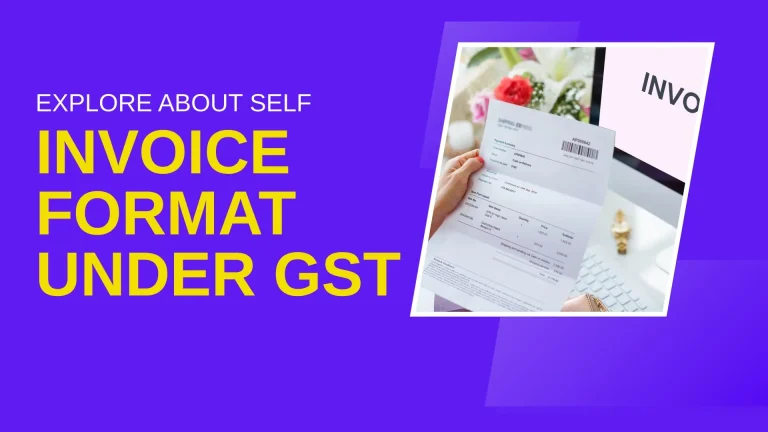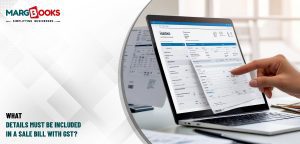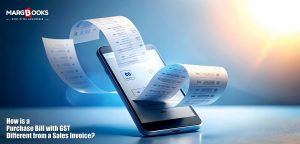The Goods and Services Tax (GST) system in India has brought significant changes to the way businesses handle taxes since it was introduced in July 2017. The main aim of GST is to simplify and unify the complex tax structure by bringing various indirect taxes under one umbrella. One important but lesser-known aspect of GST is the self-invoicing mechanism. It is essential for businesses to understand the Self Invoice Format Under GST to ensure they comply with the law and avoid any penalties.
What is a Self Invoice?
A self-invoice is an invoice that a business issues to itself. Although this might seem unusual, it is a necessary step in the GST system under specific circumstances. Self-invoicing is primarily required when a registered person buys goods or services from an unregistered supplier. Since the unregistered supplier cannot issue a GST-compliant invoice, the registered recipient must create a self-invoice for such transactions.
Why is Self Invoicing Necessary?
Under GST, every registered business must account for the GST liability on the supply of goods and services. When a business deals with unregistered suppliers, no GST is charged on these supplies because the supplier is not registered under GST and cannot collect GST. To bring these transactions into the GST system, the registered recipient must pay GST on a reverse charge basis and document the transaction through a self-invoice.
Reverse Charge Mechanism (RCM)
The reverse charge mechanism is a system where the recipient of goods or services is responsible for paying GST instead of the supplier. This is applicable in scenarios such as:
- When goods or services are supplied by an unregistered person to a registered person.
- Certain notified goods and services, regardless of the supplier’s registration status.
Components of a Self Invoice Format Under GST
Creating a self-invoice requires following specific guidelines to ensure it meets GST compliance. Here are the essential components that should be included in a self-invoice:
1. Invoice Header
The header of the self-invoice should clearly state that it is a self-invoice. It should include:
- The words “Tax Invoice” prominently displayed.
- A unique invoice number, following a sequential numbering system.
2. Details of the Supplier
Since the supplier is unregistered, the details would be minimal but should include:
- Name of the unregistered supplier.
- Address of the supplier (if available).
3. Details of the Recipient
Since the recipient is generating the self-invoice, their details should be comprehensive:
- Name of the recipient (business name).
- Address of the recipient.
- GSTIN (Goods and Services Tax Identification Number) of the recipient.
4. Invoice Date
The date on which the self-invoice is issued should be clearly mentioned.
5. Description of Goods or Services
A detailed description of the goods or services procured from the unregistered supplier should include:
- Name of the goods or services.
- Quantity of goods (if applicable).
- Unit price.
- Total value of goods or services.
6. Taxable Value and GST Details
The taxable value of the goods or services and the applicable GST rates should be mentioned. This includes:
- CGST (Central Goods and Services Tax).
- SGST (State Goods and Services Tax) or IGST (Integrated Goods and Services Tax) as applicable.
- Total GST amount.
7. Total Invoice Value
The total invoice value, including the GST amount, should be clearly stated.
8. Signature
The invoice should be signed by the authorized signatory of the recipient business.
Example of a Self Invoice Format Under GST
Here is a sample self-invoice format under GST:
Tax Invoice
Invoice Details
| Invoice Number | 001 |
|---|---|
| Date | 15th July 2024 |
Supplier Details
| Name | ABC Supplier |
|---|---|
| Address | 123, Market Street, City |
Recipient Details
| Name | XYZ Enterprises |
|---|---|
| Address | 456, Business Avenue, City |
| GSTIN | 27AAAAA0000A1Z5 |
Description of Goods/Services
| Description | Quantity | Unit Price | Total Value |
|---|---|---|---|
| Office Supplies | 10 | ₹100 | ₹1000 |
Tax Details
| Taxable Value | ₹1000 |
|---|---|
| CGST (9%) | ₹90 |
| SGST (9%) | ₹90 |
| Total GST | ₹180 |
| Total Invoice Value | ₹1180 |
Authorized Signatory
XYZ Enterprises
Compliance and Record-Keeping
Maintaining proper records of self-invoices is crucial for GST compliance. Businesses should ensure that self-invoices are correctly issued and recorded in their accounts. This involves:
1. Filing GST Returns
The details of self-invoices must be included in the GST returns. This ensures that the GST paid under the reverse charge mechanism is correctly accounted for and claimed as input tax credit, if eligible.
2. Maintaining Books of Accounts
Self-invoices should be recorded in the books of accounts, reflecting the transaction and the GST liability paid under reverse charge. This is essential for audit and compliance purposes.
3. Regular Reconciliation
Regular reconciliation of self-invoices with the purchases and expenses is necessary to ensure that all transactions with unregistered suppliers are accounted for and the corresponding GST liability is paid.
Advantages of Self Invoicing
Self-invoicing under GST provides several advantages, including:
1. Ensuring Compliance
Self-invoicing helps businesses comply with GST laws, especially when dealing with unregistered suppliers. It ensures that GST is paid on such transactions, thereby avoiding any non-compliance issues.
2. Claiming Input Tax Credit
By issuing self-invoices and paying GST under reverse charge, businesses can claim input tax credit on these transactions, reducing their overall GST liability.
3. Simplifying Accounting
Self-invoicing simplifies the accounting process for transactions with unregistered suppliers. It provides a clear record of such transactions, aiding in accurate bookkeeping and financial reporting.
Challenges in Self Invoicing
Despite its advantages, self-invoicing also presents certain challenges for businesses:
1. Understanding Compliance Requirements
Businesses need to thoroughly understand the GST laws and compliance requirements related to self-invoicing. This includes knowing when self-invoicing is necessary and the correct format for issuing self-invoices.
2. Keeping Accurate Records
Maintaining accurate records of self-invoices can be challenging, especially for businesses with numerous transactions with unregistered suppliers. Proper documentation and record-keeping practices are essential.
3. Regular Reconciliation
Regular reconciliation of self-invoices with purchases and expenses can be time-consuming but is necessary to ensure GST compliance. Businesses need to invest time and resources in this process to avoid discrepancies.
Conclusion
Understanding and implementing the self-invoice format under GST is crucial for businesses dealing with unregistered suppliers. It ensures compliance with GST laws, facilitates the claiming of input tax credit, and simplifies accounting processes. By adhering to the correct format and maintaining accurate records, businesses can navigate the complexities of self-invoicing and ensure smooth GST compliance. For businesses to stay compliant and avoid penalties, it is essential to understand the nuances of self-invoicing under GST. Regular training and updates on GST laws can help businesses keep abreast of any changes and ensure they are following the correct procedures. By doing so, businesses can not only stay compliant but also optimize their GST liability management.
Also Read
- What Details Must be Included in a Sale Bill with GST?Getting your GST paperwork wrong feels like walking through a minefield, doesn’t it? One missing detail on your invoices, and suddenly you’re dealing with compliance headaches that could’ve been easily avoided. Creating a proper Sale Bill with GST isn’t rocket… Read more: What Details Must be Included in a Sale Bill with GST?
- How Is a Purchase Bill with GST Different from a Sales Invoice?Running a business in today’s GST-enabled economy requires more than just selling and buying. It’s about being organised, compliant, and aware of what each document in your billing system stands for. One common confusion many businesses face is the difference… Read more: How Is a Purchase Bill with GST Different from a Sales Invoice?
- How Can You Generate a Mobile GST Bill in Seconds?Running a shop is hard enough. But when billing takes forever and GST compliance gets messy, things can slow down. That’s where a Mobile GST Bill comes to the rescue. Whether you run a busy garment store or a local… Read more: How Can You Generate a Mobile GST Bill in Seconds?
- What Happens If GST on Advance Received Is Not Paid on Time?Running a business in India requires keeping pace with ever-evolving tax laws, and GST in advance is one such area that many businesses often overlook sometimes unintentionally. But missing out on timely GST payment on advances can lead to unnecessary… Read more: What Happens If GST on Advance Received Is Not Paid on Time?
- How Does the 9988 HSN Code Impact GST Filing for Businesses?Navigating the complexities of GST can be daunting, especially for service-based businesses in India. Among the many elements of GST compliance, the HSN (Harmonised System of Nomenclature) code plays a crucial role in categorising goods and services. One such classification… Read more: How Does the 9988 HSN Code Impact GST Filing for Businesses?
Frequently Asked Questions
What is a self-invoice under GST?
A self-invoice is an invoice that a registered business issues to itself when purchasing goods or services from an unregistered supplier. This is necessary because the unregistered supplier cannot issue a GST-compliant invoice. By generating a self-invoice, the registered recipient records the transaction and pays the GST on a reverse charge basis. This ensures that the transaction is documented and the GST is accounted for, even though the supplier is not registered under GST.
Why do businesses need to create self-invoices?
Businesses need to create self-invoices to comply with GST regulations when dealing with unregistered suppliers. Since unregistered suppliers cannot charge GST, the registered recipient must pay the GST on a reverse charge basis. Creating a self-invoice helps document the transaction, ensuring the GST liability is correctly recorded and paid. This process allows the registered business to claim input tax credit on the GST paid and maintain accurate records for tax compliance and audit purposes.
When is self-invoicing required under GST?
Self-invoicing is required under GST when a registered person purchases goods or services from an unregistered supplier. This is necessary because the unregistered supplier cannot issue a GST-compliant invoice. Additionally, self-invoicing is required for certain notified goods and services, regardless of the supplier’s registration status. By creating a self-invoice, the registered recipient ensures that the GST is paid on a reverse charge basis, bringing the transaction into the GST system and complying with tax regulations.
What details must be included in a self-invoice?
A self-invoice must include several key details to ensure GST compliance. These details include:
1. The words “Tax Invoice” prominently displayed.
2. A unique invoice number following a sequential numbering system.
3. The name and address of the unregistered supplier.
4. The name, address, and GSTIN of the recipient.
5. The date of the invoice.
6. A detailed description of the goods or services, including quantity, unit price, and total value.
7. The taxable value, applicable GST rates, and total GST amount.
8. The total invoice value, including GST.
9. The signature of the authorized signatory of the recipient business.
How does reverse charge mechanism work in self-invoicing?
In self-invoicing, the reverse charge mechanism (RCM) means that the recipient of goods or services is responsible for paying GST instead of the supplier. When a registered person buys from an unregistered supplier, the supplier cannot charge GST. Therefore, the registered recipient must pay the GST directly to the government. The recipient generates a self-invoice to document the transaction and pays the GST on a reverse charge basis. This ensures that the transaction is recorded, and the GST is paid, complying with GST regulations.
Can businesses claim input tax credit on self-invoices?
Yes, businesses can claim input tax credit (ITC) on self-invoices. When a registered business generates a self-invoice and pays GST under the reverse charge mechanism, the GST paid can be claimed as ITC. This reduces the overall GST liability of the business. However, to claim ITC, businesses must ensure that self-invoices are accurately recorded in their books of accounts and included in their GST returns. Proper documentation and adherence to GST compliance requirements are essential for successfully claiming ITC on self-invoices.
How should businesses maintain records of self-invoices?
Businesses should maintain accurate records of self-invoices to ensure GST compliance. This includes:
1. Recording self-invoices in the books of accounts, reflecting the transaction and GST liability paid under reverse charge.
2. Including the details of self-invoices in GST returns to account for the GST paid and claim input tax credit, if eligible.
3. Regularly reconciling self-invoices with purchases and expenses to ensure all transactions with unregistered suppliers are accounted for and the corresponding GST liability is paid.
4. Keeping self-invoices and related documents organized and easily accessible for audit and compliance purposes.
What are the challenges businesses face with self-invoicing?
Businesses face several challenges with self-invoicing, including:
1. Understanding the compliance requirements and correctly issuing self-invoices when necessary.
2. Maintaining accurate records of self-invoices, especially for businesses with numerous transactions with unregistered suppliers.
3. Regularly reconciling self-invoices with purchases and expenses to ensure all transactions are accounted for and the corresponding GST liability is paid.
4. Investing time and resources in proper documentation, record-keeping, and reconciliation practices to avoid discrepancies and ensure compliance with GST regulations.
Are there penalties for not issuing self-invoices?
Yes, there can be penalties for not issuing self-invoices as required under GST. Failure to comply with self-invoicing requirements can result in non-compliance with GST regulations. This can lead to penalties, fines, and interest charges on the unpaid GST liability. Additionally, businesses may face challenges in claiming input tax credit without proper documentation of transactions with unregistered suppliers. To avoid penalties and ensure smooth GST compliance, businesses must understand and adhere to self-invoicing requirements and maintain accurate records.
How can businesses stay updated on self-invoicing requirements?
1. Regularly attending GST training sessions and workshops to understand the latest compliance requirements.
2. Subscribing to newsletters and updates from GST authorities and professional tax advisory services.
3. Consulting with tax professionals and experts to ensure they are following the correct procedures.
4. Reviewing official GST websites and resources for any changes or updates to self-invoicing rules.
5. Implementing internal processes and systems for regular review and reconciliation of self-invoices to ensure compliance with current GST regulations.






